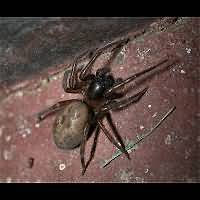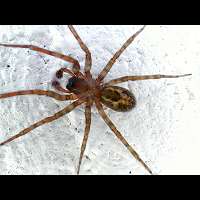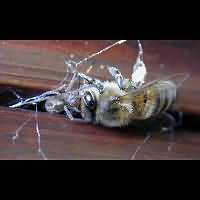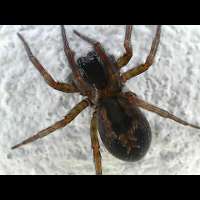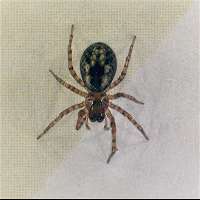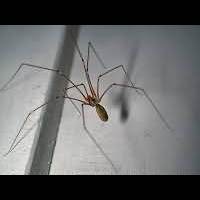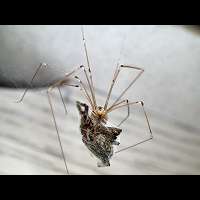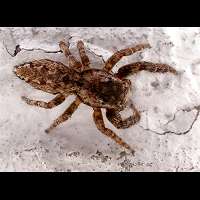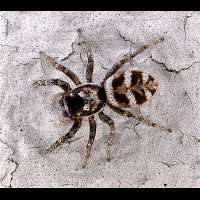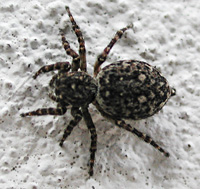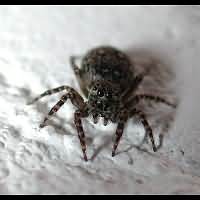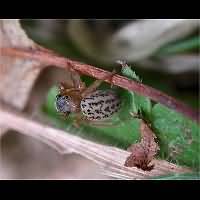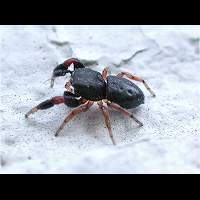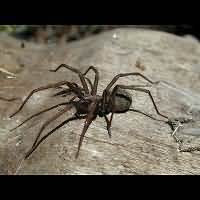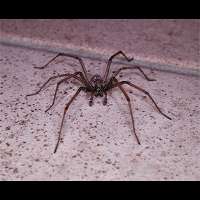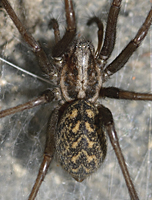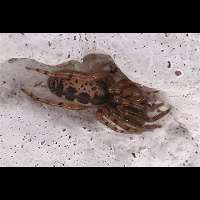[All pictures of garden wildlife on this page are thumbnails. Click on any thumbnail for a large format to be displayed.]
House Spiders
The spiders on this page are usually found in the house, on the walls, in attics or on fences rather then in the garden. This does not mean you will never find them outdoors. Jumping spiders for instance are also seen on tree trunks. Most species though are frequently encountered in or around the house. This division in spiders is by no means scientifically correct. Hopefully it will help you in finding a species on this website quickly.
Contents: 1 Funnel Web Spiders 2 Daddy Long Legs Spiders 3 Jumping Spiders, 4 Cob-web Spiders, 5 Six-eyed Spiders.
![]()
1 Funnel Web Spiders (Amaurobiidae)
In Holland there are three species of funnel web spiders. In the Southern Limburg and in Belgium there are two more species, but these are rare. Two Funnel Web Spiders live in or near houses. Actually there are two spider families, the species of which are referred to as house spiders. The Funnel Web Spiders, which usually have ordinary legs and which are shiny and the Cob-Web Spiders, which look bigger, because of their long legs which are hairy and therefor not shiny at all. Mind you: the Hobo Spider, an American spider that bites, is a Cob Web Spider. Do not be afraid of shiny house spiders as they are harmless! Funnel Web Spiders build their web during the night. You can observe the web building easily as they are not shy and the light of a strong torch will not disturb the construction of a web.
This is one of the many house spiders: Amaurobius similis. The female is on the left, the male is on the right.
The species below is also found on the buildings outdoors but rarely inside. It can often be spotted near windows which explains its Latin name Amaurobius fenestralis. Spiders often eat prey that is much bigger than they are. Very often you can see small spiders wrestling with much bigger crane flies. The one below to the left is eating a Honeybee. It is hard to tell the two Amaurobius species apart. Usually A. similis is the bigger of the two, slightly lighter in colour and found inside houses regularly. A. fenestralis is often found on outside walls, but also on trees, especially under loose bark, where A. similis is rare. Normally A. fenestralis has two or three v-shaped markings on the abdomen, where A. similis has four. Taking all this into account we are pretty sure the spider in the pictures below is Amaurobius fenestralis.
This house spider, Amaurobius fenestralis, often lives in chinks in walls, especially near window-frames, but it can also be found on the trees under loose bark.
Below is a very young house spider, which probably is an Amaurobius fenestralis as well, but the young of these species are rather alike, so it could be a young Amaurobius similis as well. It was found in February, overwintering under a flower pot.
This is a young, overwintering house spider. Probably Amaurobius fenestralis, but it could be Amaurobius similis as well.
2 Daddy Long Legs Spiders (Pholcidae)
This is a very small family of spiders. In Western Europe only three spieces can be found. Still this family is also known as Cellar Spiders or Vibrating Spiders. This shows that this is a very common spider indeed: it can be found in many homes, especially in dark rooms, such as atticks, cellars and bathrooms. You should be careful: the Daddy Long Legs Spider is a real spider and not a Harvestman, even though it has got the same kind of long legs. When another spider is approaching it starts to vibrate intensely (actually it is making small circles rapidly). The attacker then looses focus, making an attack very difficult. It is the defense strategy used by all members of the family. The Cellar Spider is a big eater and it even attacks much larger House Spiders and, if possible, even its own kind. In the picture below to the right it is eating a Common Housespider (Tegenaria atrica).
A very common spider in the house: the Daddy Long Legs Spider or Vibrating Spider or Cellar Spider (Pholcus phalangioides).
3 Jumping Spiders (Salticidae)
Jumping spiders are named after their hunting method: they jump on their prey, often from quite a distance. Before jumping they attach a wire to the surface they are sitting on. In this way they can always return to the place they jumped from. They never weave a web though. Because they jump on their prey, jumping spiders have to be able to judge the distance. That can be best done with two (or four) eyes slightly apart thus giving a stereoscopic view. People and owls have two adjacent eyes just for that purpose. The jumping spiders have six eyes and two of them are extremely large. Their main function is to estimate distance. Lidy and André identified the male of the spider below to the left and Kurt knew that the other pictures were of a female of the same species. I was not able to find a common English name for this spider, so I presume it doesn't have one. The Zebra Spider below to your right is a very small species and it is less than one centimeter in size. You can often find it on sunny spots on walls. When you have its attention it will lift its head in order to follow every your movement with the big eyes. It can be 'tamed' and accepts food: it will gladly take a plant louse offered using a set of pincers.
To the left: this is a typical jumping spider: Marpissa muscosa. To the right: the Zebra Spider (Salticus scenicus) usually jumps to catch its prey.
The spider below resembles a jumping spider, but the big, round belly would indicates other species. Most jumping spiders are not as lumpy as this one is. Still it is a jumping spider (a female) of the Sitticus gender. It lives not only in Europe, but in the USA as well.
This is a female of Sitticus pubescens, a common jumping spider.
The spider below to the left is a very small jumping spider, which you will probably encounter raking old leaves, or when your garden has lots of trees in them because it mainly lives in forests. It is very small (less than 5 mm) so it is close to the limits of what our camera can capture without extra magnifying devices. It is very remarkable seeing the jumping spider below to the right in your garden. The species is not often seen. Luckily it is easily identified, because of the striking front legs, which are ringed an partly swollen. The males use these legs to impress each other and females.
To the left: this very small jumping spider is called Euophrys frontalis. To the right: Sibianor aurocinctus, a striking but quite rare Jumping Spider.
4 Cob-web Spiders (Agelenidae)
To this family belongs one of the biggest Western European spiders that can often be found in the house: Common House Spider. There are four species, that resemble one another very much. They can be found indoors regularly and this is the most common one of them. Especially during the night the males often actively search for the females. Females are hardly bigger than males and actually look smaller: the males have a leaner body, but much longer legs. The infamous North American Hobo Spider, also known as Biting House Spider (Tegenaria agrestis) is a close relative of the Common Housespider below and it does look similar. The animal is not known to bite people in Europe, but somehow it does bite in the USA. The venom causes open wounds that heal very slowly. Most of the members of the Tegenaria genus however are either unable to penetrate the human skin or their venom is very weak indeed.
Much feared by many people: the Common Housespider (probably Tegenaria atrica) ![]()
5 Six-eyed Spiders (Segestriidae)
This spider probably lives in your garden rather than on the walls of your house. But it is rather difficult to find in the garden, if you succeed at all. It lives in holes and crevices in bark and occasionally on walls, where it can catch your eye more easily. It's part of a small family, represented in Britain by three species only. Like the family name implies, Six-eyed Spiders do have six eyes only. These are placed on three groups of two eyes each. The members of this family have an elongated abdomen. They build little webs with which they keep in touch in their little hole. When a prey stumbles over the wires, the spider quickly comes out of its hiding place and attacks the victim. The way they are waiting is quite interesting and characteristic too: the last pair of legs is stretched backwards while all other pairs are kept in the front and are always bent. Males and females are almost identical: the size is roughly the same and so are the markings on the abdomen. The only difference is that the male has a shorter and more slender abdomen. Segestria senoculata is quite easy to recognise due to the markings on the abdomen.
This species is unmistakably Segestria senoculata because of the markings on the abdomen.


© Copyright 1998-2024 gardensafari.net (Hania Berdys)

 English / engels
English / engels  Dutch / nederlands
Dutch / nederlands